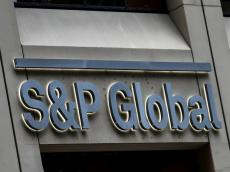|
|
TODAY.AZ / Business
S&P publishes expectations on oil prices impact on inflation and rates
07 October 2023 [21:30] - TODAY.AZ

However, the price of Brent crude is up 28% since the end of June, topping $95/barrel, in part because of production cuts announced by Saudi Arabia.
"Higher energy prices could slow, or delay, future interest rate reductions by emerging markets' (EM) central banks," S&P Global Ratings report reads.
"Energy generally has a significantly higher weight in the consumer price index (CPI) baskets of EMs than in those of developed economies. In the median EM, energy prices, which include both fuels for transportation and electricity at home, account for 10% of the CPI basket (see chart 2). In the US, for example, they account for 6.9%. In some EMs, the energy weight in the CPI is two to three times higher than that of the US. In Poland, for example, energy prices account for 18.3% of the basket, and 13.3% in Hungary."
"Lower average energy prices than last year have fueled the disinflation prcocess, but the recent increase in the price of oil, if sustained, could slow, or even reverse this trend. Energy price increases in the median EM have slowed from 15.5% year over year in 2022, to 4.2% so far this year, as of August," S&P said.
Two main caveats are worth noting. So far, natural gas prices, which before the Russia-Ukraine conflict generally moved together with oil prices, have remained relatively stable in recent months. "This means that the price of electricity, which in many cases is fueled by natural gas, may not increase much, unless natural gas prices also start moving significantly higher. In addition, several EMs have energy prices (electricity and/or fuel) that are regulated by the government, which means that increases in international energy prices don't always translate to similar increases in domestic energy prices. In those cases, the government typically absorbs those costs through subsidies," the study's authors note.
According to them, the recent increase in oil prices comes at a time of renewed broad US dollar strength, amplifying the potential impact on inflation in EMs. In Chilean pesos, oil prices are nearly 45% higher since the end of June, 40% in Hungarian forints, and about 35% in Polish zloty and Turkish lira terms.
"If the recent increase in oil prices persists, several EM central banks could opt to slow or delay expected interest rate reductions, especially in the case of large net energy importers. In these countries, external account balances could deteriorate substantially in the event of higher energy prices, and this typically exerts depreciatory pressure on the domestic currency (while increasing external financing needs). In this scenario, EM central banks would likely hesitate to lower interest rates substantially, to prevent disorderly capital outflows, which would weaken currencies further," S&P stressed.
Within the group of large EM net energy importers, higher energy prices could slow the pace of interest rate reductions in Chile, Poland, and Hungary, delay the start of rate cuts in Thailand, the Philippines, and India, and encourage more rate hikes than what is already expected in Türkiye.
"The Turkish central bank has been shifting to more orthodox monetary policy, which meant battling double-digit inflation (near 60% year over year in August) with large increases in interest rates. Its one-week repo reference rate has gone up from 8.50% in June to 30% currently and is expected to continue heading higher in the coming months. Higher energy prices could increase inflation expectations and amplify pressure on interest rates," reads the S&P study.
URL: http://www.today.az/news/business/239842.html
 Print version
Print version
Connect with us. Get latest news and updates.
See Also
- 27 April 2025 [09:00]
Forging future of multipolar economic resilience in shifting global order [OPINION] - 26 April 2025 [13:55]
Iran-Azerbaijan cooperation could boost economic and regional potential, says Iranian official - 26 April 2025 [10:26]
Azerbaijan’s logistics corridors key to boosting Asia trade, expert says - 25 April 2025 [19:00]
Private sector makes up 83% of GDP, says Deputy Minister - 25 April 2025 [15:39]
Deputy Minister highlights digital economy and Alat Free Economic Zone at Conference - 25 April 2025 [14:55]
Focus on Garabagh and sustainability at upcoming Baku Forum - 25 April 2025 [14:31]
ASCO hosts MEPC 83 Seminar on maritime emissions and sustainability - 24 April 2025 [15:49]
Azerbaijan, ADB discuss development priorities for next four years - 24 April 2025 [12:55]
Azerbaijan achieves major milestones in ICT development, boosts cybersecurity and talent - 24 April 2025 [11:00]
Azerbaijan’s banks shielded from US tariff impact, Fitch reports
Most Popular
 Pakistan warns of danger of "all-out war" as Kashmir crisis escalates
Pakistan warns of danger of "all-out war" as Kashmir crisis escalates
 Kaja Kallas: EU-Azerbaijan ties advancing on a ‘two-way path’
Kaja Kallas: EU-Azerbaijan ties advancing on a ‘two-way path’
 Austria’s OMV shuts down hydrogen filling station network due to ‘lack of demand’
Austria’s OMV shuts down hydrogen filling station network due to ‘lack of demand’
 South Korea ask United States to exempt its goods from duties
South Korea ask United States to exempt its goods from duties
 Azerbaijan and Pakistan FMs hold phone conversation on strategic partnership & regional security
Azerbaijan and Pakistan FMs hold phone conversation on strategic partnership & regional security
 Azerbaijan to host founding conference of Global South NGO Platform in Baku
Azerbaijan to host founding conference of Global South NGO Platform in Baku
 EC blacklist organizations associated with Huawei
EC blacklist organizations associated with Huawei
